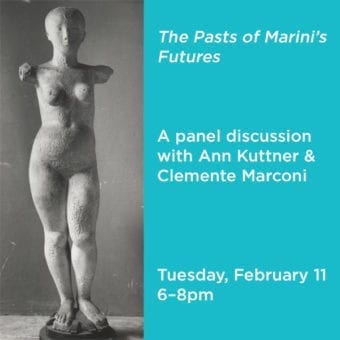Book presentation with author Giorgia Gastaldon
April 15, 2021
Giorgia Gastaldon, PhD, in conversation with CIMA Fellows discussed her new book, the first comprehensive monograph on Mario Schifano’s early work (1958-1964).
Mario Schifano–resolute painter in years in which Italian art was taking the path of dematerialization–was an artist for whom the categories of character, legend, biography–one that was tormented, exaggerated, cursed–have long prevailed over a thoughtful consideration of the works.
This book, part of a series, the Studi of the Bibliotheca Hertziana, published in collaboration with Silvana Editoriale, examines Schifano’s pictorial evolution focusing on the blazing beginnings of his production–from 1958 to 1964, when he first participated in the Venice Biennial–and studies it starting with the most neglected fundamentals: considering documents from that time period; identifying, dating, and sequencing his works; analyzing his pictorial language in comparison to that of artists from his same period; and, lastly, bringing it back to the culture–visual and broader–of his time. The result is a Mario Schifano less character, and more artist, less fluctuating, and more rigorous in his research, the value of which lies in consistency, in the timeliness and autonomy of his choices, as well as in the instinctive joy of his painting.
Giorgia Gastaldon is currently adjunct professor at L’Università dell’Aquila. Previously she worked as post-doc researcher at the Bibliotheca Hertziana, where she developed a project focused on Italian women artists in the Sixties. In 2014 she obtained a PhD in Art History from the University of Udine with a dissertation on Mario Schifano’s Painting 1958-1964, which has been published in 2021. In 2017 she was awarded a postdoctoral fellowship at Center for Art Studies Ragghianti, where she developed a research project on Carlo Ludovico Ragghianti and the Museum of Contemporary Art in Florence, which became a book in 2019. Between 2014 and 2016 she spent two-years as research fellow in the framework of the FIRB ministerial project Spreading visual culture: contemporary art through periodicals, archives and illustrations.
Alongside her academic career, she works as curator of exhibitions: she has been appointed as scientific director of Palinsesti (San Vito al Tagliamento, PN) between 2015 and 2019 and as co-curator of the exhibition Carla Accardi. Contesti (Museo del Novecento, Milan) between 2019-2021.
She published several scientific essays, articles and monographs focused, in particular, on the themes of the reception of American art in Italy, on the role played by magazines in the Italian artists’ update, on the Italian art critic frame, and on women artists production in the Sixties.
This event is made free to the public thanks to support from Christie’s.
![]()
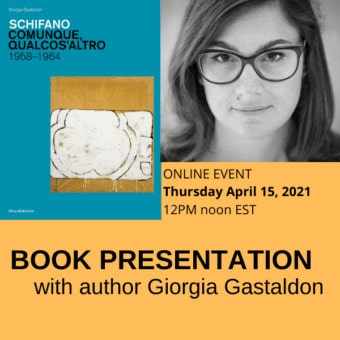
Schifano and Friends: Holly Miller
April 08, 2021
This talk and Q&A, part of a broader series titled Schifano and Friends, covers the Italian artist’s friendship with American artist Holly Miller and the impact that Schifano’s aesthetic sensibility had on her work.
This series of talks and conversations with art historians, writers, curators, and artists, highlights thematic and aesthetic intersections between the work of Mario Schifano and his American peers.
Holly Miller was born in Buffalo, NY and raised in Rome, Italy. She graduated from School of Visual Arts in 1984 with a Bachelor of Fine Arts. She has shown nationally and internationally. Selected exhibitions include the Serpentine gallery in London, the Brooklyn Museum, the University of Kentucky Art Museum in Lexington, the Weatherspoon Art Museum in Greensboro NC, Gilman Contemporary gallery in Ketchum Idaho, ARENA, Lesley Heller gallery, Elizabeth Harris gallery and McKenzie Fine Art in NY and the Studio Stefania Miscetti gallery and Sala Uno in Rome. Her work is in the collections of the Arkansas Art Center, the Weatherspoon Art Museum and the University of Kentucky Art Museum. She lives and works between Brooklyn and Vermont.
Our digital programming is made free to the public thanks to sponsorship from:
![]()
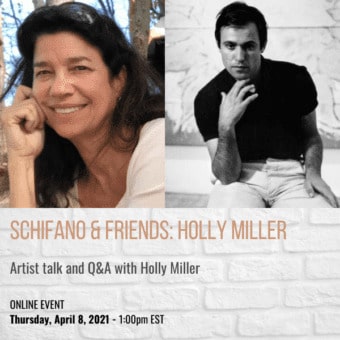
Schifano and Friends: Dacia Maraini
March 30, 2021
This exclusive conversation, part of a broader series titled Schifano and Friends, will explore Dacia Maraini’s long friendship with artist Mario Schifano, the cultural circles of 1960s Rome, and the poem and interview that Maraini dedicated to the painter over the years.
Dacia Maraini is an Italian novelist, poet, playwright, and public intellectual, widely known and published in over twenty countries. The daughter of a Sicilian princess and a renowned ethnologist, Maraini was born in Fiesole, near Florence, and from an early age began journeying with her family, following her father’s research travels in Japan. Maraini became a protagonist of Rome’s cultural scene during the 1960s—the context in which she met and befriended Mario Schifano. In 1973, she was among the founders of Teatro la Maddalena, a women-run theater in the capital that produces some of her most famous plays, such as Maria Stuarda and Dialogo di una prostituta col suo cliente. A prolific author, Maraini’s plays and novels tackle themes such as personal freedom for women, the abuse of power and its effect on women, the histories of women that break free from traditional gender roles, social activism, and women liberation. She has won several important literary awards for her work, including the Formentor Prize for L’età del malessere (1963); the Premio Fregene for Isolina (1985); the Premio Campiello and Book of the Year Award for La lunga vita di Marianna Ucrìa (1990); and the Premio Strega for Buio (1999). Several of her novels have been adapted into successful films by major Italian directors.
This event is made free thanks to funding from:
![]()
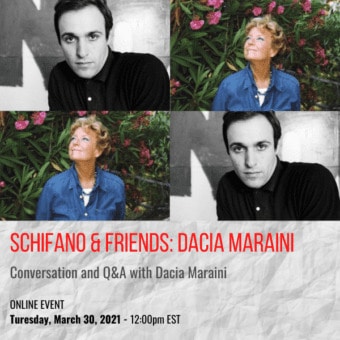
Schifano and Friends: Robert Rauschenberg
March 18, 2021
This lecture and Q&A, part of a broader series titled Schifano and Friends, will cover the Italian artist’s familiarity with Robert Rauschenberg and the impact that his work had on Schifano’s aesthetic sensibility.
This series of talks and conversations with art historians and curators, will highlight thematic and aesthetic intersections between the work of Schifano and that of American artists from the 1950s and 1960s.
Julia Blaut is Director of Curatorial Affairs at the Robert Rauschenberg Foundation. A graduate of Smith College, the Institute of Fine Arts, NYU, and the Whitney Independent Study Program, Blaut was formerly Assistant Curator at the Solomon R. Guggenheim Museum. It was at the Guggenheim that her work on Rauschenberg began, in connection with the artist’s late career retrospective in 1997. She has curated, taught, and published in the field of postwar American art.
This event is made free to the public thanks to funding from:

BOOK PRESENTATION WITH SILVIA BOTTINELLI
March 11, 2021
A conversation between Dr. Silvia Bottinelli (CIMA Travel Fellow, 2016-17) and CIMA Research Fellows Virginia Magnaghi and Carlotta Vacchelli, in occasion of the publication of Dr. Bottinelli’s scholarly book, Double-Edged Comforts: Domestic Life in Modern Italian Art and Visual Culture (McGill-Queen’s University Press, 2021).
The book unveils the untold story of Italian domestic experiences through the lens of artists and image-makers that focused their gaze on the intimate space of the home, during the course of decades that led from the trauma of World War II to the frenzied optimism of the postwar reconstruction.
Silvia Bottinelli is a Modern and Contemporary Art historian in the Visual and Material Studies Department at the School of the Museum of Fine Art at Tufts University. She received her PhD from the University of Pisa in 2008.
Her research on 20th and 21st century art has been widely published in art magazines and scholarly journals, such as Art Journal, Modernism/modernity, Public Art Dialogue, California Italian Studies, Art Papers, Sculpture, Palinsesti, Predella, Ricerche di Storia dell’Arte, Artribune, and Exibart, among others. She co-edited the volume The Taste of Art. Cooking, Food, and Counterculture in Contemporary Art Practices (University of Arkansas Press, 2017) with Margherita d’Ayala Valva. Furthermore, she authored the books SeleArte. Una Finestra Sul Mondo (2008), and Un Premio Dimenticato. La Collezione del Fiorino alla Galleria d’arte moderna di Palazzo Pitti (2007). She received grants from the American Philosophical Society, the Italian Art Society, and the Center for Italian Modern Art to work on the book we present here today, Double-Edged Comforts: Domestic Life in Modern Italian Art and Visual Culture, published by McGill-Queen’s University Press, which analyzes the representation of the domestic sphere in Italian art and visual culture from the 1940s to the 1970s.
Presented in partnership with:

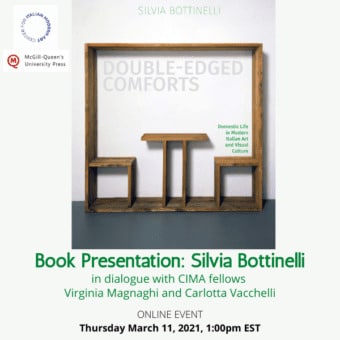
Schifano and Friends: Jasper Johns
February 23, 2021
This conversation and Q&A, part of a broader series titled Schifano and Friends covers the Italian artist’s friendship with Jasper Johns, as well as the reciprocal influence each had on the other.
This series of talks and conversations with art historians and curators, highlights thematic and aesthetic intersections between the work of Schifano and that of American artists from the 1950s and 1960s.
Flavio Fergonzi was born in Pavia in 1963. He teaches the History of Modern Art at the Scuola Normale Superiore di Pisa. His research interests include the sculpture of the nineteenth century (Rodin and Michelangelo. A Study of Artistic Inspiration. Philadelphia: Philadelphia Museum of Art, 1997) and of the twentieth century (L’arte monumentale negli anni del fascismo. Arturo Martini e il Monumento al Duca d’Aosta. Turin, Allemandi: 1992, with Maria Teresa Roberto). He has also worked on the history of twentieth-century art criticism (Lessicalità visive dell’Italiano. La critica dell’arte contemporanea 1945-1960. Pisa: Scuola Normale Superiore, 1996), and on Italian twentieth-century Avant-Garde (The Mattioli Collection: Masterpieces of the Italian Avant-Garde. Milan: Skira, 2003; Filologia del 900. Modigliani Sironi Morandi Martini. Milan: Electa, 2013). This last 2020 he published in Italy a book on Jasper Johns’ influence on Italian Art of 1950s and 1960s (Una nuova superficie. Jasper Johns e gli artisti italiani, 1958-1966).

Curator Talk with Francesco Guzzetti, Facing America: Mario Schifano, 1960–65
February 11, 2021
What did artists growing up in Rome in the 1950s and 1960s think about, when they thought about America? Such a key subject in Italian postwar and contemporary art can be articulated by looking at the early life and practice of Mario Schifano, one of the most relevant representatives of the new generation of artists rising in Rome at the end of the 1950s. Francesco Guzzetti will expand on the relationship between the painter and American art and culture between 1960 and 1965. Ideally walking through the exhibition, the major figures and moments which the American connections of Schifano revolved around will be taken into consideration vis-à-vis the evolution of the artist’s distinctive style and figurative interests.
Francesco Guzzetti, PhD, is the curator of the exhibition Facing America: Mario Schifano 1960-1965, currently on view at the Center for Italian Modern Art in New York (Jan. 26-Jun. 5, 2021). Dr. Guzzetti holds a doctoral degree in History of Modern and Contemporary Art from the Scuola Normale Superiore in Pisa. His field of expertise is postwar and contemporary Italian art, with special focus on its connections with international tendencies in the 1960s and the 1970s. Dr. Guzzetti’s research has been supported by various pre and post-doctoral fellowships and grants by institutions such as CUNY Graduate Center and the Center for Italian Modern Art in New York; Centre Pompidou in Paris; Harvard University; and Magazzino Italian Art Foundation in Cold Spring, New York. More recently, he was the 2019–20 Postdoctoral Fellow at the Drawing Institute at the Morgan Library and Museum in New York. He has curated exhibitions and published essays on numerous subjects in the history of modern and contemporary art. He is the author of the book Ennio Morlotti e l’arte a Milano 1937-1953 (Milan: Scalpendi Editore, 2020) and is currently working on a publication about the connections between American and Italian art in the early 1970s.
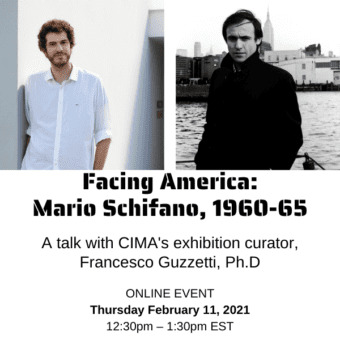
OPENING FACING AMERICA: MARIO SCHIFANO, 1960–1965
January 14 - 26, 2021
The first U.S. institutional exhibition of painter Mario Schifano (1934–1998), explores the artist’s work from 1960 to 1965 together with art by his American contemporaries. A leading figure of Italian postwar and contemporary art, Schifano redefined painting through his multifaceted practice, as he marked the transition from postwar abstraction to the new figuration of the 1960s. Reassessing the tenets of painting and exploring multiple media, Schifano elaborated a radical visual vocabulary as early as at the beginning of the 1960s. His practice was prescient: his work pre-dates international Pop art and is comparable to the revolution Andy Warhol carried out in the United States during the same years.
EXPERIENCE CIMA
The best way to experience CIMA is through a fellow-guided tour. An intimate conversation with a scholar in residence encourages visitors to forge deeper connections with the artworks on view.
Let’s look together again.
In-Person Tours: $15 /visitor. Free for CIMA members.
CIMA’s signature fellow-guided tours are conducted in our spacious and meditative SoHo loft. Tours are by appointment only at 11am and 2pm on Fridays. No more than 8 visitors are permitted on a tour.
Open Hours: $10/visitor. Free for CIMA members.
Visitors to CIMA’s open hours can experience the exhibition on their own between 11am –4pm on Saturdays by appointment only. Visits are timed and no more than 12 visitors are permitted per hour.
NEW: Virtual Fellow-Guided Tours: $10/visitor.
For its 2021 season CIMA will offer LIVE online discussions led by a fellow-in-residence. These presentations, enjoyed from the safety of your own home, reimagine CIMA’s signature visits. Tours are 45-minutes, maximum 20 people per group, and available on Sundays at 11am. Visitors will receive a private zoom link to access their tour 24 hours prior to the event.
Private Virtual Adult, Corporate and School Group Tours
CIMA welcomes private groups for virtual tours. $300 flat fee per adult group. Schools visit free. To request an appointment, please contact martin@italianmodernart.org at least two weeks in advance.
CIMA Members enjoy special private visiting hours Monday – Thursday by appointment. Membership begins at just $125. Learn more at italianmodernart.org/membership.

Marino Marini / Parviz Tanavoli: Reception and Translation of Influence
March 10, 2020
In the 1950s, Parviz Tanavoli went to Italy where he studied first in Carrara and then in Milan with Marino Marini. This lecture by Fereshteh Daftari will highlight the nature of the encounter between the Italian master and his pupil, who has come to be known as the father of Iranian modern sculpture. Tracing the trajectory of Marini’s influence as it was translated and expanded into a modernist language in tune with the Iranian context will be the focus of the presentation.
REGISTER HERE
Program schedule:
6pm: registration, aperitivo, and viewing of Marino Marini: Arcadian Nudes
6:15pm – program begins, followed by audience Q&A
8pm – Evening concludes
Curator and scholar Fereshteh Daftari received her Ph.D. in Art History from Columbia University (1988). Her dissertation, The Influence of Persian Art on Gauguin, Matisse and Kandinsky, was published in 1991. During her tenure at the Museum of Modern Art in New York (1988 – 2009), she curated a number of international exhibitions including Without Boundary: Seventeen Ways of Looking (2006). She was co-curator of Between Word and Image at New York University’s Grey Art Gallery in 2002, and Iran Modern at the Asia Society Museum in New York in 2013. She has also focused on contemporary art. Action Now, the first exhibition of contemporary Iranian performance art, was held in Paris (2012); Safar/Voyage: Contemporary Works by Arab, Iranian, and Turkish Artists at the University of British Columbia’s Museum of Anthropology in Vancouver (2013); and Rebel, Jester, Mystic, Poet: Contemporary Persians at the Aga Khan Museum in Toronto (2017). It then traveled to the Museum of Fine Arts in Houston and in 2020 it will go to the Asia Society Museum in New York. Daftari has published widely and her most recent book is titled Persia Reframed: Iranian Visions of Modern and Contemporary Art (London: I.B. Tauris/Bloomsbury, 2019).

The Pasts of Marini’s Futures
February 11, 2020
Clemente Marconi and Ann Kuttner work on the art of Mediterranean antiquity, and its own issues of reception and retrospection. For this CIMA program, they conduct a dialogue about how Marini positioned his statuary practice in relation to what he would have known as very old – including Greek, Roman and Etruscan remains – in ways that were complementary to how he positioned that work relative to his contemporaries’ production. Such rapprochement with antiquity was claimed often by Marini, who even called himself ‘an Etruscan.’ They will weigh those claims against telling divergence from the classical record, on the one hand, and on the other explore resonances Marini never voiced explicitly but which the works themselves suggest.
In keeping with CIMA exhibition, one topic will be Marini’s female nudes, from miniature to monumental, from swollen lumpy torsos as of women aged by childbearing to exaggeratedly taut bodies, from mannered primitivism to the Neoclassical. (And do they echo the sacrality of so many ancient prototypes?) How these multiples of what Marini named the nymph ‘Pomona’ lived in the studio and in his own mind as seriated things, as here at CIMA, suggests the great galleries of Roman replica statuary Marini must have known. His cropping of limbs and head expresses that cult of the fragment that is so much a part of the appeal of archaeological traces to modernist sensibilities. Such aspects inform how Marini’s images both praised and caged the feminine. Just like their ancient prototypes, these statues often represented the increase of the earth, and pitted artifice against nature; that can’t help but have had political resonance. Marini explicitly attributed political messages to his seriated horsemen, as protests against modern threats of technologically enabled mass violence. For the female nudes, too, and their promise of auspicious fertility, which Marini spoke of, politics are in question. We ourselves, at a time of what many think a human undoing of Nature, might meditate what Marini’s engagement with Ovid’s fruit-bringing nymph could speak to in our age. And for all Marini’s retrospectives, the attempted Fascist appropriation of Etrusco-Roman antiquity, to adorn revived Italian greatness, has to have inflected Marini’s understanding of what it meant for him to stubbornly claim, reclaim, or turn his back on Italian classicisms of many kinds.
Ann Kuttner is Associate Professor in the Dept. of History of Art at the University of Pennsylvania, active in the Graduate Groups in Art and Archaeology of the Mediterranean World and in Ancient History. Author of Dynasty and Empire in the Age of Augustus: The Case of the Boscoreale Cups (1995, Univ. of California Press), co-editor with Alina Payne of Antiquity and Its Interpreters (2000, Cambridge Univ. Press), she teaches and publishes broadly on arts of the Hellenistic, Roman and Late Antique world, not least those of Italy. That includes special interests in sculpture, political art and domestic display, and in retrospective images, cross-cultural interaction, and the post-antique reception of the ‘Classical.’ Recent essays include, for instance, ‘(Re)presenting Romanitas at Sir John Soane’s House and Villa,’ in K. von Stackelberg and E. Macaulay-Lewis eds., Housing the New Romans: Architectural Reception and Classical Style in the Modern World (2017), and ‘A Tortured Image: The Biography of Lucullus’ Dying Hercules,’ in CIS: California Italian Studies Journal 6.1, 2016.
Clemente Marconi is the James R. McCredie Professor in the History of Greek Art and Archaeology and University Professor at the Institute of Fine Arts–NYU, and Professore Ordinario di Archeologia Classica in the Dipartimento di Beni Culturali e Ambientali of the Università degli Studi di Milano. The director of the Institute of Fine Arts–NYU and Università degli Studi di Milano archaeological mission on the acropolis of Selinunte, he is the author of Temple Decoration and Cultural Identity in the Archaic Greek World (Cambridge University Press, 2007) and the editor of The Oxford Handbook of Greek and Roman Art and Architecture (Oxford University Press, 2014).
